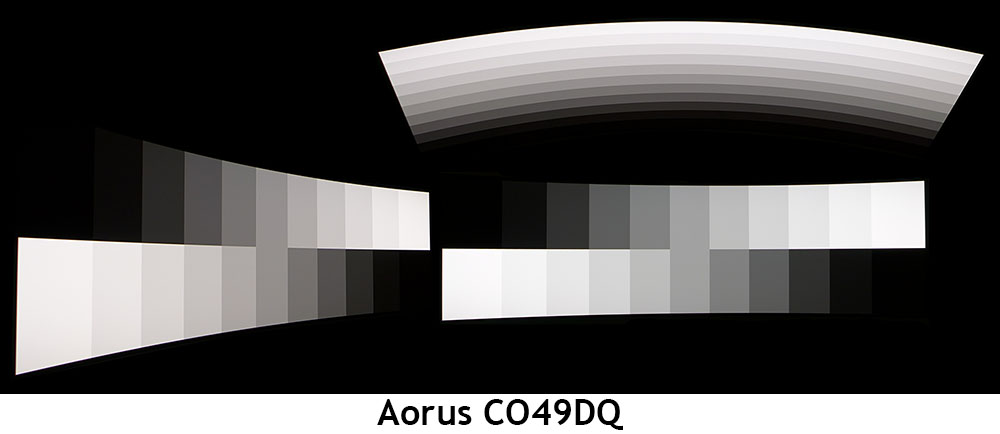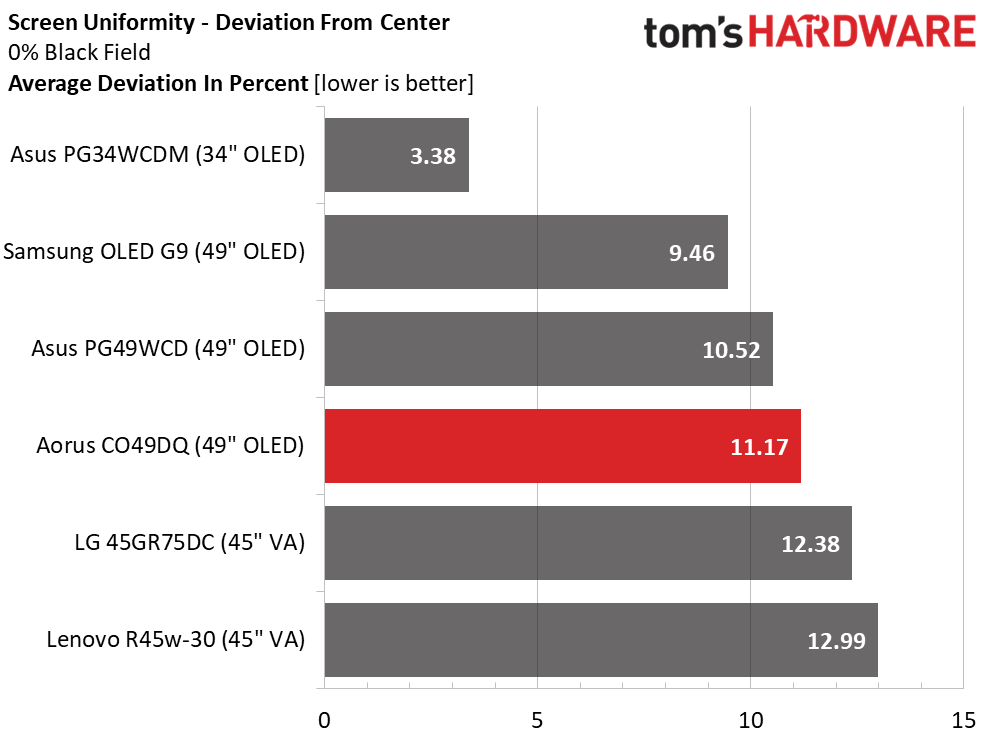Why you can trust Tom's Hardware
To compare the CO49DQ’s performance, I rounded up three other wide OLEDs, Asus’ PG49WCD and PG34WCDM and Samsung’s OLED G9. Yes, the PG34WCDM is a 34-inch 21:9, but it is close in price. I added two VA screens to fill out the group: Lenovo’s R45w-30 and LG’s 45GR75DC.
Pixel Response and Input Lag
Click here to read up on our pixel response and input lag testing procedures.


If you’ve read my recent OLED reviews, you know I’m hot on the 240 Hz segment and the above charts show why. With 4ms draw times, the faster screens have no motion blur at frame rates above 200fps. The CO49DQ at 144 Hz has a bit of blur. It isn’t much, but it is there. The only 240 Hz 32:9 monitor available currently is the G9, but it will set you back $200 more than the Aorus. The two VA panels are in the mix with decent scores, but they need their overdrive to come close to the OLED’s motion quality and smoothness.
Input lag scores go hand in hand with refresh rates, with the happy exception being the CO49DQ, which is extremely responsive. This helps mitigate some of that blur and makes it a quick monitor.
Test Takeaway: Though the CO49DQ shows some motion blur at its 144fps maximum, it has impressively low input lag, making it an excellent gaming monitor. I would still gravitate to a 240 Hz screen, but if you don’t have a super-fast/expensive video card, 144 Hz is enough for a solid experience.
Viewing Angles
It’s hard to find fault with OLED viewing angles, so I must get picky. The CO49DQ has an extremely subtle red shift at 45 degrees to the sides. This is a trait found in all QD-OLEDs but it’s such a minor issue that it is barely worth mentioning. You can see a 10% reduction in light output too. From every angle, gamma remains consistent which keeps detail clearly rendered. The CO49DQ is perfectly shareable by two users.
Screen Uniformity
To learn how we measure screen uniformity, click here.
Get Tom's Hardware's best news and in-depth reviews, straight to your inbox.
With the room completely dark, I could see a slight bit of extra light down the center of my CO49DQ sample when viewing a 10% gray pattern. Black fields are completely free of visible or measurable light. The issue is not visible in content and not worthy of concern.
MORE: Best Gaming Monitors
MORE: How We Test PC Monitors
MORE: How to Buy a PC Monitor
MORE: How to Choose the Best HDR Monitor
Current page: Response, Input Lag, Viewing Angles and Uniformity
Prev Page Features and Specifications Next Page Brightness and Contrast
Christian Eberle is a Contributing Editor for Tom's Hardware US. He's a veteran reviewer of A/V equipment, specializing in monitors. Christian began his obsession with tech when he built his first PC in 1991, a 286 running DOS 3.0 at a blazing 12MHz. In 2006, he undertook training from the Imaging Science Foundation in video calibration and testing and thus started a passion for precise imaging that persists to this day. He is also a professional musician with a degree from the New England Conservatory as a classical bassoonist which he used to good effect as a performer with the West Point Army Band from 1987 to 2013. He enjoys watching movies and listening to high-end audio in his custom-built home theater and can be seen riding trails near his home on a race-ready ICE VTX recumbent trike. Christian enjoys the endless summer in Florida where he lives with his wife and Chihuahua and plays with orchestras around the state.
-
parkerthon Really interesting, and finally a price that has me seriously considering try an oled monitor ultra wide. But being that my desktop is used for my job 95% of the time, which often requires Teams screen sharing of presentations, I’m trying to wrap my head around how that would work. Is there a way to virtually split my desktop for powerpoint presentation mode that throws slides on one screen and a presenters view on another? I use this a lot. I do see some third party utilities that might do this, but curious if anyone out there has experience with this.Reply -
Giroro This is wider than the last-reviewed ASUS PG34WCDM, less expensive, and much less curved.Reply
It seems to have a lot going on.
I would need to see the curve in person, because it is such a hard thing to convey through pictures.
I wish best buy had better variety to their in-store displays. -
PEnns Seems like a really good monitor. But I have to ask: Does it really have to be curved? The size is (allegedly) the same, so why the curve? Curved might be more tolerable at 32", but 49" is a bit too much (IMHO).Reply
Or maybe the main consideration for some: More immersive? Well, maybe, but many will get the same experience from the same 49" monitor and most likely it will be less expensive! -
AkroZ Reply
There is many advantages to the curve.PEnns said:Seems like a really good monitor. But I have to ask: Does it really have to be curved? The size is (allegedly) the same, so why the curve? Curved might be more tolerable at 32", but 49" is a bit too much (IMHO).
Or maybe the main consideration for some: More immersive? Well, maybe, but many will get the same experience from the same 49" monitor and most likely it will be less expensive!
Firstly for this screen of 49 inch it reduce the width to 47 inch with better readability, your eyes need less distance to find the corners.
On a flat screen the center is good but due to the angles of view the pixels becomes more and more deformed on the edges and smaller (from the viewer perspective), this also reduce the perceived lights making the corners darker.
Those makes corners more difficult to read. Here it's a curved 1800R screen, if you place your eyes at 1,8 meter from screen then all pixels will remain squares everywhere horizontally (because it is not curved vertically) making the lighting consistent.
But for that you need to be centered, so it's only for one person, for a presentation monitor or a TV it's better to be flat.
About the cost of curving, OLED is a flexible surface by nature, it's mainly a choice of form for the rigid support and adapt the assembling chain. This will not really cost more materials. Customers are generally paying a premium fee but you can find some curved monitors at the same price than non-curved monitors. -
Notton can confirm. With 2x 27" side by side, I have to put them in a V shape to read stuff at the outer edges.Reply -
TheHerald A 49" Super ultra wide monitor is not very practical, trust me, had one for 2 years.Reply -
subspruce I can't imagine how I would even use all of that display, or even fit this on my desk, but your desk may be huge and you may need the equivalent of 2 25" monitors side-by-side for whatever you may be doingReply


